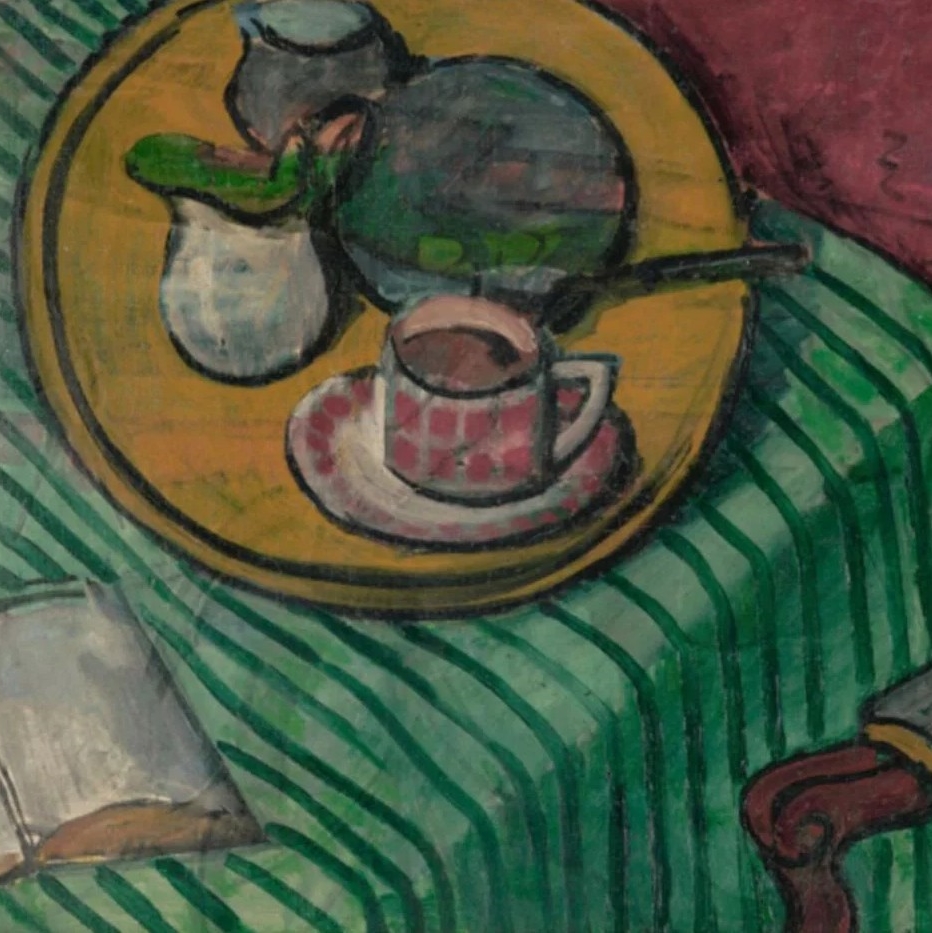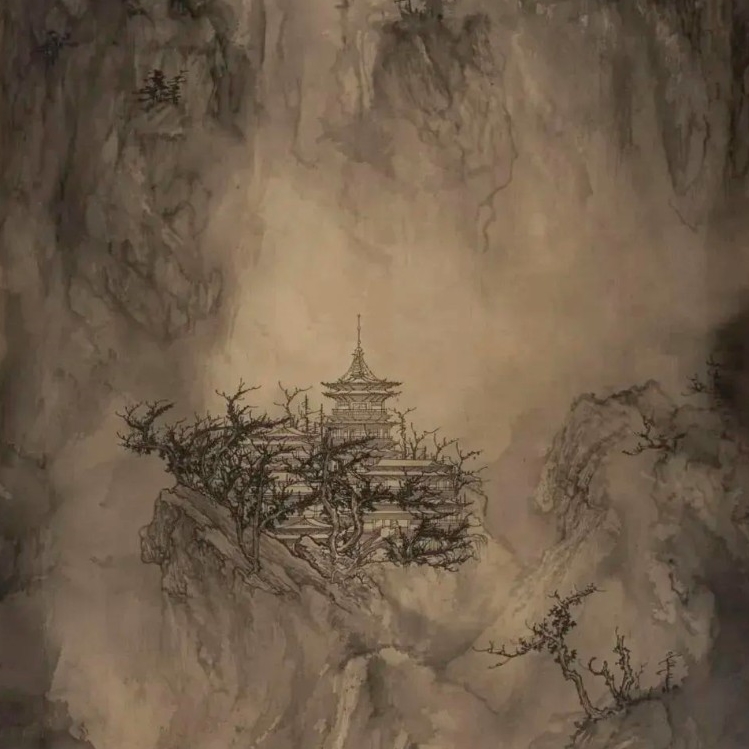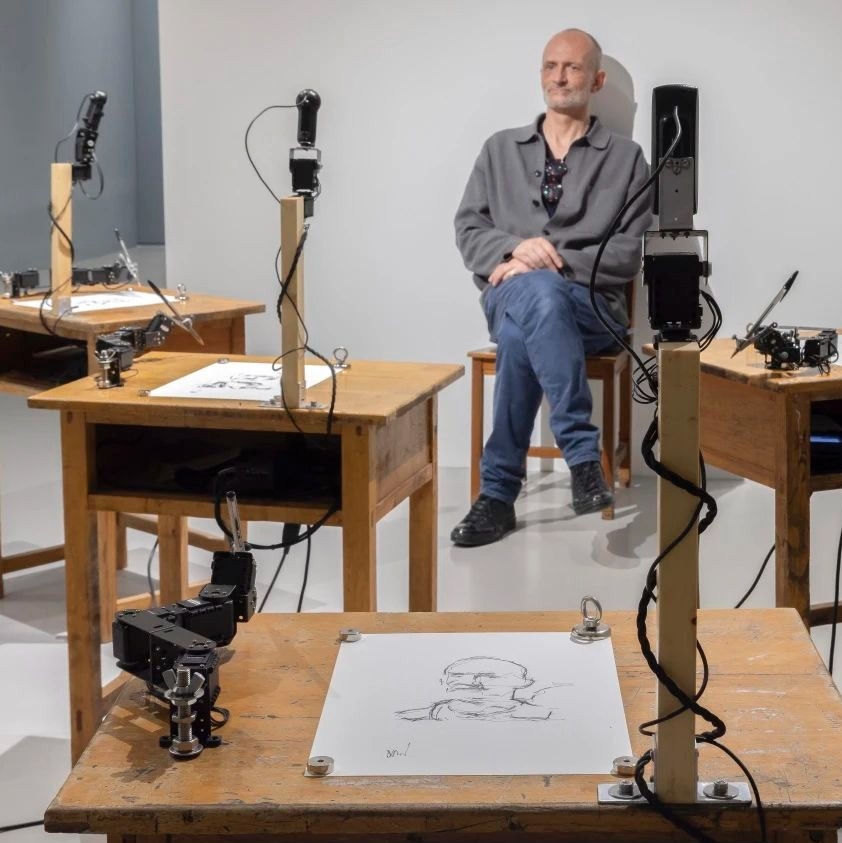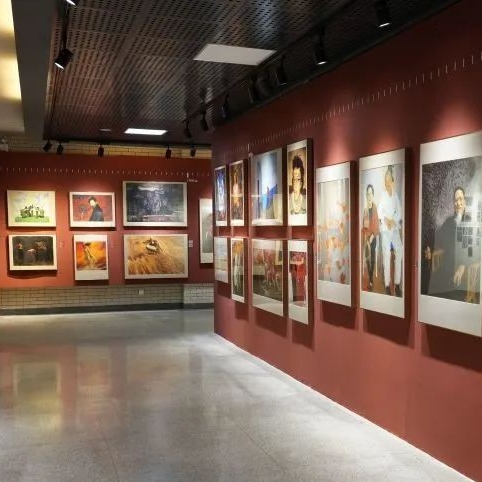
Xu Bing has remained highly sensitive to the epoch that he lives in during the creative process for over 40 years, while his work has always been closely related to social issues. Through his creative process from craftsmanship to thinking and with the guidance of thinking on craftsmanship he has achieved a balance and mutual promotion between “art” and “technique.” The diverse and penetrating nature of art media he has mastered is recognized and acclaimed internationally as well as in the world of contemporary art which affects the overall composition and depth of contemporary Chinese art on various levels. What’s more important is that the core of Xu Bing’s artistic mentality transforms and reconstructs the fixed understanding of people through literary, humorous and wise creative vocabulary, and it further activates and promotes previous thinking, providing a new perspective and bringing new thoughts.

Exhibition View of Monkeys Grasp for the Moon at Museum of Art Pudong in 2021; Image Courtesy of Xu Bing Studio and Museum of Art Pudong
 Exhibition View of “Xu Bing: Found in Translation” at Museum of Art Pudong in 2021; Image Courtesy of Xu Bing Studio and Museum of Art Pudong
Exhibition View of “Xu Bing: Found in Translation” at Museum of Art Pudong in 2021; Image Courtesy of Xu Bing Studio and Museum of Art Pudong
A large-scale research-oriented solo exhibition entitled “Xu Bing: Found in Translation” was grandly unveiled at the Museum of Art Pudong. It is an exhibition that focuses on Xu Bing’s self-contained artistic concepts and practices, with literary language and artistic language as the main thread, it showcases the profound ideological essence and academic theories which are unique in his work. From an artistic perspective, it encourages a multi-dimensional discussion of significance and value of Chinese culture in a new context throughout the world, as well as its positive influence on the joint efforts for world civilization. With Hans De Wolf from the Free University of Brussels in Belgium serves as the Academic Chair, the exhibition was planned and designed by Sun Hua, Feng Yu and Zhao Yifeng from the AHA Union.
Over 70 (sets) of Xu Bing’s representative works and latest masterpieces from the 1980s are distributed on the first and third floors of the Museum of Art Pudong, covering prints, installations, archive records, manuscripts, videos and documentaries. The exhibition is composed of three sections: studies on characters and languages, comparative study of calligraphy and painting language and new artistic methods. The inherent connection between his works has been fully expressed and embodied in the path through the exhibition, the exhibition design and artist statement which were concluded from the contents.


Exhibition View of “Xu Bing: Found in Translation” at Museum of Art Pudong in 2021; Image Courtesy of Xu Bing Studio and Museum of Art Pudong
Exhibits on the first floor explain the thinking and morphological changes of Xu Bing’s creation on characters and languages from experiment to maturity, from Eastern vocabulary to an international context. Five Series of Repetitions, as a conceptual and technical print preparation for and the prelude to Book from the Sky, can be seen as an important clue throughout the creative process, but it was generally ignored with continuously emerging works. The “plurality” and “restriction” of prints are endowed with the genetic characteristic of contemporary art and the origin of its core can be traced in media, advertisements, logos and the internet. There has always been a high degree of symbiosis between prints and texts in history. Book from the Sky, with about four thousand “fake” Chinese characters appear as real ones, the creation of this piece took four years from its conception to completion. While applying ancient hand-engraving and printing methods, 120 sets of four volumes of Book from the Sky were handcrafted. The meticulous and exhaustive process of production and formation, composed like ancient Chinese classics, were formed so that audiences could not believe that these exquisite texts were completely illegible.

Exhibition View of “Xu Bing: Found in Translation” at Museum of Art Pudong in 2021; Image Courtesy of Xu Bing Studio and Museum of Art Pudong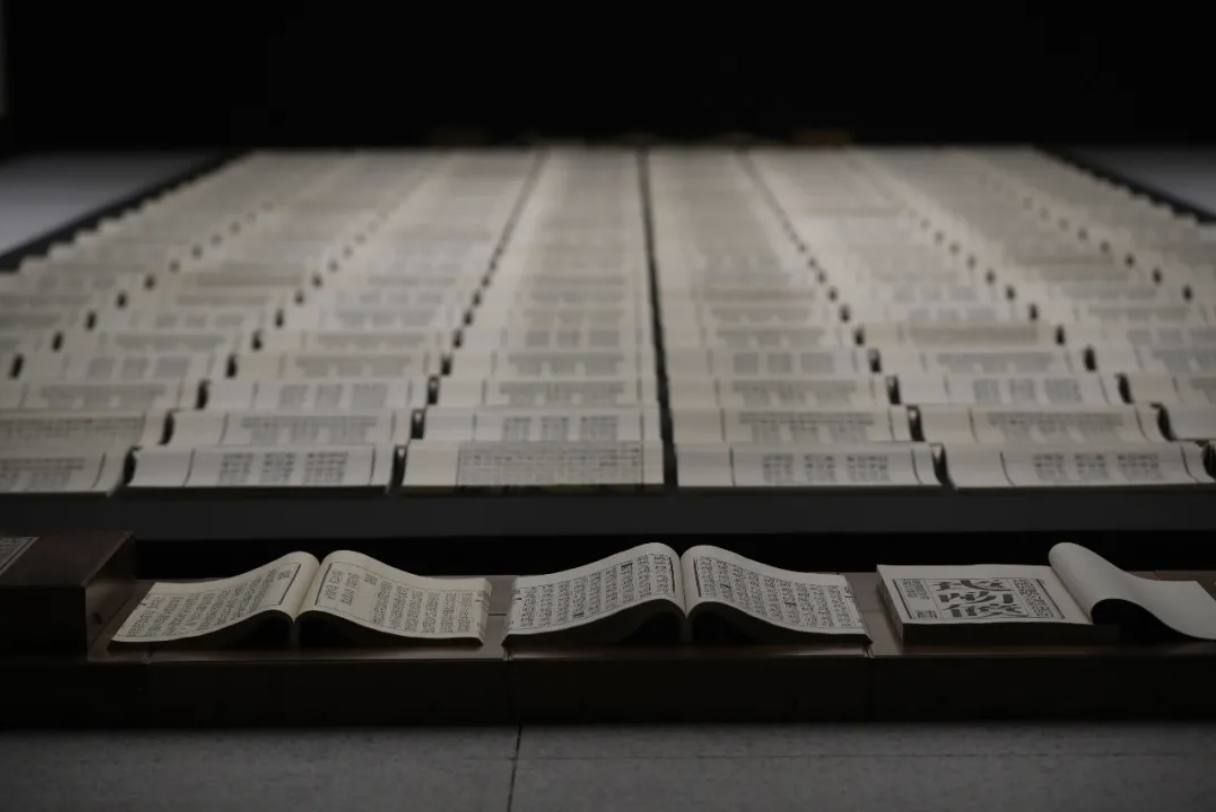

Exhibition View of Book from the Sky in “Xu Bing: Found in Translation” at Museum of Art Pudong in 2021; Image Courtesy of Xu Bing Studio and Museum of Art Pudong
Writing is the cornerstone of human culture and it has exerted a fundamental influence on human thinking. Xu Bing used English creation to adapt and understand the similarities and differences of various languages and cultures, from A, B, C…, Telephone, Post Testament to Square Word Calligraphy, he has gradually formed a unique method of “cultural grafting.” Square Word Calligraphy is a writing system that resembles the format of Chinese characters but actually turns out to be English. It interweaves Chinese calligraphy with the writing of Latin letters, developing a new concept of language. The sense of obstruction, doubt, and confusion of the audience are relieved after brainstorming with the artwork. Because of this, an oriental calligraphy culture is introduced to the West.

Exhibition View of Book from the Ground in “Xu Bing: Found in Translation” at Museum of Art Pudong in 2021; Image Courtesy of Xu Bing Studio and Museum of Art Pudong
As early as 2003, Xu Bing has already foreseen and captured the value and future direction of the images of text and network communication methods, in addition to traditional language and writing, he explored the possibility of communication and developed the series of Book from the Ground, which has improved rapidly along with the development of the internet era. The differences in knowledge and regional cultures have been gradually weakened and the ideal that we can share the same language has begun to be activated. Visual expressions of this proposition can be reflected in the special relation in dialogue between Monkeys Grasp for the Moon and Gravity of Civilization (to be presented in the central exhibition hall from April 2022). The entanglement and competition between different cultural perspectives which were triggered by special languages of art ensure that the audience are encouraged to think of how they influence, complement and correct each other, and the possibility of people of different races, believes and values share and construct the world.
The first interactive installation that the audience may come cross on the third floor is Square Word Calligraphy Classroom, when the audience participate, they are reminded of their memories and desire for learning. When they are invited to face the unprecedented logic of Square Word Calligraphy, their familiar thinking process will be broken while the existing knowledge concept will be suspended. The audience has to look for a new supporting point for the concept and to find the starting point of thinking and understanding.


Exhibition View of Square Word Calligraphy Classroom in “Xu Bing: Found in Translation” on the third floor of Museum of Art Pudong in 2021; Image Courtesy of Xu Bing Studio and Museum of Art Pudong
Attaching dried plantation, newspapers, plastic bags and other debris to the frosted glass, the artist presents to the audience a Chinese ink painting composed of light with Background Story. It evokes his thoughts about the unique relationship between Chinese landscape painting and nature. Background Story is a light and shadow painting that appears in the air as it is not formed by the three-dimensional effect of blending and imitating pigments, but through the use of light. To put it another way: the light that is scattered in the space is regulated and its state is recorded through a pane of rice paper glass that cuts off the space. The function of this rice paper glass is like a slice of light in the air.


Exhibition View of Background Story: Dwelling in the Peach Blossom Valley at Museum of Art Pudong in 2021; Image Courtesy of Xu Bing Studio and Museum of Art Pudong
There are conceptual differences between Eastern and Western paintings: the Western realistic painting draws three-dimensional images on a two-dimensional plane and it is presented in a three-dimensional way. One of the key features of Chinese painting is “symbolic”, which is directly related to Chinese characters. In his creation of Mustard Seed Garden Landscape Scroll, Xu Bing uses the backward inference method of mathematics to deepen his comprehension of the “stylized” characteristics of Chinese art. Painting Manual of the Mustard Seed Garden, embodies typical pictorial paradigms and it can be used as a “dictionary” of symbols and radicals depicting everything in the world. People who study painting can express their individual tastes on the premise of following the paradigms, just like allusions in poetry. Actually “stylization through copying” is an important part of Chinese culture. Any tradition must be activated before it is easy to use. The essence of Chinese thought processes, cultural attitudes and views on the world can be the nourishment for the progress and development of our logic.

A Sketch for Landscripts; Image Courtesy of Xu Bing Studio and Museum of Art Pudong
For anyone who is familiar with Xu Bing can perceive that he and his work have a temperament that is different from this noisy era. This is actually the spirit of traditional Chinese literati who “see the simplicity and embrace the plainness”, following the natural process, cherishing its quality while also keeping it modest and sincere. In front of the Landscripts series, the audience can intuitively experience this simplicity. When Xu Bing was visiting the mountains and rivers, while confronting the real mountains, he wrote the word “mountain”, and he wrote the word “water” near the water, combining characters to form a landscape painting. This can be called calligraphy or painting as well. It can even be regarded as an article. The lifelong pursuit of Chinese literati in poetry, calligraphy, painting, and seal, Xu Bing integrated this through his unique way of transforming the general principle into simplicity. In the current world full of variables, what role can Eastern spirit and energy play in balancing, regulating, and merging the complexity of human civilization? Some enlightenment may be obtained from the hand-drawn animation The Character of Characters. The writing of Chinese characters over thousands of years has influenced the Chinese people’s way of thinking, cultural character and attitude towards the world. Writing Chinese characters emphasizes the sequence of strokes. Each stroke is determined according to the position of the previous stroke and the last stroke is the key. Adjusting the defects and balance of the whole character will have the effect of turning things around. The philosophy of the inter-frame structure of Chinese characters subtly makes the Chinese people’s grasp of the relationship of things into a set of system.

Exhibition View of A, B, C… at Museum of Art Pudong in 2021; Image Courtesy of Xu Bing Studio and Museum of Art Pudong
Collection of Tags for Book from the Ground at Museum of Art Pudong in 2021; Image Courtesy of Xu Bing Studio and Museum of Art Pudong
Xu Bing adheres to the simplicity and wisdom in the essence of Chinese language and culture, with soft artistic techniques against rigid ones to confront the issues of the global society. No matter where he is, he always maintains a profound introspection and reflection on everything in front of him. What can an artist do when faced with major events in the world? With artistic wisdom, he brings people from all over the world into a larger perspective and theme, to explore the essential relationship between spiritual space and material, what is more eternal and stronger? What is a real power? Staring at the gray dust in a quiet atmosphere and saying “As there is nothing from the first, where does the dust itself collect?” How should we deal with the chaos and crises of the world?


Exhibition View of “Xu Bing: Found in Translation” at Museum of Art Pudong in 2021; Image Courtesy of Xu Bing Studio and Museum of Art Pudong
Exhibition View of Tobacco Project on the third floor of Museum of Art Pudong in 2021; Image Courtesy of Xu Bing Studio and Museum of Art Pudong
Things are happening and changing, and the truly valuable parts will gradually appear. The process from craftsmanship to thinking and then guiding craftsmanship is the natural process of Xu Bing’s artistic creation, and it is also the core value of Xu Bing’s art and method. With a specific and large amount of manual work, repeated practice of daily materials, careful consideration and polishing of every detail, the artistic ideas are then rigorously implemented. When the concept is firm, his artistic theme is refined to the extreme. Xu Bing has always insisted on showing his work in an extremely simple, essential and modest as well as sincere appearance, while also wary of the false void and obscurity that are prone to appear in contemporary art. This humility is rare and precious in the world today. Through this simple presentation, let the work “speak”, let the language of art take effect, and effectively communicate with the audience. Through the Tobacco Project, it can be seen that when faced with creative themes that are so rich that the choice of media is decisively limited to the tobacco-making materials. The value of work comes from the starting point of tobacco without any subjective judgment. When they are regarded as non-attributable materials, thinking and horizons can be expanded infinitely. If there is always moral judgment or concerns about vital interests, the truth cannot be seen.


Exhibition View of Tobacco Project on the third floor of Museum of Art Pudong in 2021; Image Courtesy of Xu Bing Studio and Museum of Art Pudong
Xu Bing always believes that another characteristic of artistic language is about the complementary and supporting relationship of each work. The earlier work is an annotation to the later work, and the latest work is a rediscovery of the earliest work. The variation and energy of society are constantly being injected into creative inspiration. Under the appearance of seemingly dislocated, multi-layered social issues so cultural thinking is vocalised, through the transformation of the old artistic methods and the prompting of new languages, the frontier of art is continuously stretched and expanded. The creation of Phoenix originated from thinking about urbanization, new workers and capital accumulation. The contrast between the glamorous modern buildings and the crude working and living conditions of the construction workers shocked the artist. As a result, the use of construction materials, construction waste, tools for labour and workers’ daily necessities were developed to create a huge pair of Phoenix. Wherever Phoenix goes, more significance is activated by the unique local history and culture. Every take-off of Phoenix is a reconstruction of meaning. Since every piece of material for the Phoenix has been touched by the hands of laborers, they have their own divine quality and this pair of Phoenix is full of scars but has their own dignity. This contemporary work draws on folk art techniques and uses the cheapest materials to express positive expectations for a better life in the future.

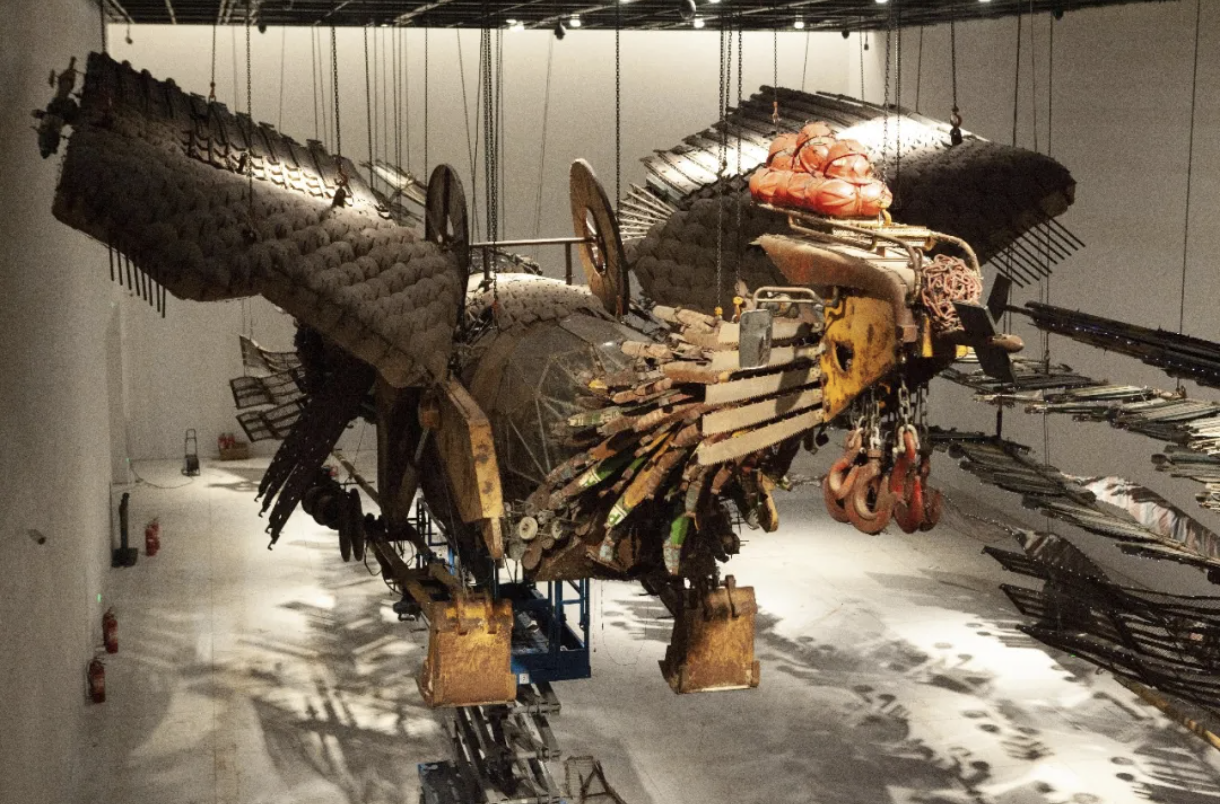
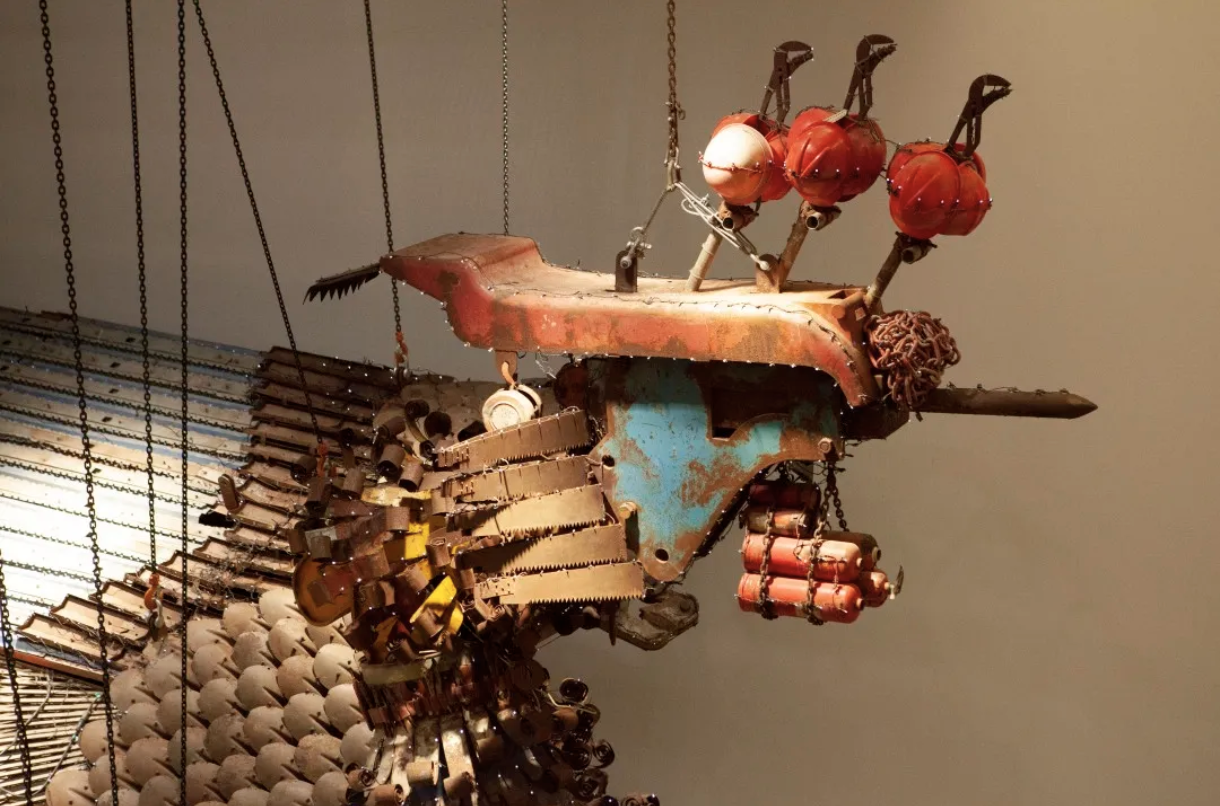
Exhibition View of Phoenix at Museum of Art Pudong in 2021; Image Courtesy of Xu Bing Studio and Museum of Art Pudong
With the rapid development in artificial intelligence, bioengineering, and space technology, the existing civilization of mankind is facing a difficult dilemma. In this situation, where is the foothold of art? Human civilization is advancing in a role dominated by rational logic, and the left and right brains are coordinated: the left-brain people are busy with sorting, and the right-brain people are busy with disrupting the sorting, because creativity can only occur when the sorting is uncoordinated. The best ratio of rationality and the non-sensical provides the conditions for the development of civilization. What is invisible to science can be seen with art, and vice versa. The ubiquitous surveillance cameras make this world a huge studio. With the help of this new phenomenon and materials, Xu Bing created Dragonfly Eyes which is called “a film that has never been seen in the film history.” The core of the work is very experimental and avant-garde, but its attribute is still the use of art, keeping a vigilant and cautious distance from fancy cultural gimmicks and definitions, and guarding what an artist should do today.
In the face of rapid changes in the epochal developments, the persistence in art itself has increasingly enhanced its own special and irreplaceable value. On the road to non-stop creation, no matter how the art form is renovated or the art boundary changes, it is Xu Bing’s fundamental position to present and convey the human spirit through artistic language. Art creation is a matter of continuous growth. Through the use of the wisdom of Eastern thinking so new thinking is injected into the world’s contemporary civilization, he draws energy from materials and languages that are still developing while triggering the old artistic language with a keen sense of society. The transformation of methods and languages have been continuously deepened and Xu Bing has expanded the coordination system of art linguistics and semiotics to explore the future of art ecology.
Courtesy of the Artist and Museum of Art Pudong, edited and translated by Sue/CAFA ART INFO
Preface
 Work Shot of Xu Bing for “Xu Bing: Found in Translation” at Museum of Art Pudong in 2021; Image Courtesy of Xu Bing Studio and Museum of Art Pudong
Work Shot of Xu Bing for “Xu Bing: Found in Translation” at Museum of Art Pudong in 2021; Image Courtesy of Xu Bing Studio and Museum of Art Pudong
The curator penned this exhibition title, in which I see two layers of meanings: one referring to the use of language as a means of art-making; the other being the invention of unprecedented artistic language.
Language is one of the most essential elements of our human existence. To know and touch a language means to touch the core of a culture, while to transform a language means a transformation of the most fundamental part of thinking. The ties between Chinese characters and their pictorial origins have influenced not only the cultural and philosophical characteristics of China, but also why China has evolved to what it is today. Between the complex and coded systems of various languages across the globe, what is still to be discovered and utilized in the furtherance of human civilization? This remains a subject of interest to me. I often find it unbelievable that after entering a cybernetic and interstellar world, we still communicate with ancient symbols and pictographic glyphs, as if operating in both past and present. Considering all mentioned above, we should consider ourselves fortunate and extraordinary. My art is thus guided by the peculiar charm of language as I view it.

Work Shot of Xu Bing for “Xu Bing: Found in Translation” at Museum of Art Pudong in 2021; Image Courtesy of Xu Bing Studio and Museum of Art Pudong
What is the definition of art? I would say art arrives from the artists who, faced with time and honesty, have their own stories to tell. It takes a brand-new way of communicating to deliver a message without sacrificing a certain clarity of feeling. Methods once used by the old masters or those that I have used in the past cannot be reused, because of the simple fact that both my surroundings and myself have since changed. Consequently, one has to find another effective language. This is exactly where new artistic expression is born, the seed of innovation germinating as decisions in the creative process begin to change—the treatment of materials, the placement of shape and color, the judgment of compositional harmony, the extent to which the artist needs to relinquish control, etc. All decisions comprise a quintessential slice of the final pie. This is what the artist does for a living. In this respect, it is one’s sensitivity towards the surrounding world and time that inspires the revolution of existent artistic structures.


Work Shot of Xu Bing for “Xu Bing: Found in Translation” at Museum of Art Pudong in 2021; Image Courtesy of Xu Bing Studio and Museum of Art Pudong
What an artist attempts to do throughout their career is to establish a strong “closed cycle” of work, which is uniquely and solely theirs. Each piece from their portfolio is complementary to the rest. As the earliest works serve as reference to provide light for the latest ones, the latest works also fill in that which is neglected in the earliest ones.
I always remind myself that the “closed cycle” will inevitably get broken when faced with the changes of the times, requiring the artist to pursue a new and effective language to restore the cycle all over again. Making art is something of continuous growth.
Thank you for visiting the exhibition. Thank you, Museum of Art Pudong. Thank you, all who made this show possible.
Xu Bing
Nov. 22nd, 2021
Courtesy of the Artist and Museum of Art Pudong
About the exhibition

Dates: December 24, 2021-August 23, 2022
Venue: Museum of Art Pudong, Shanghai


